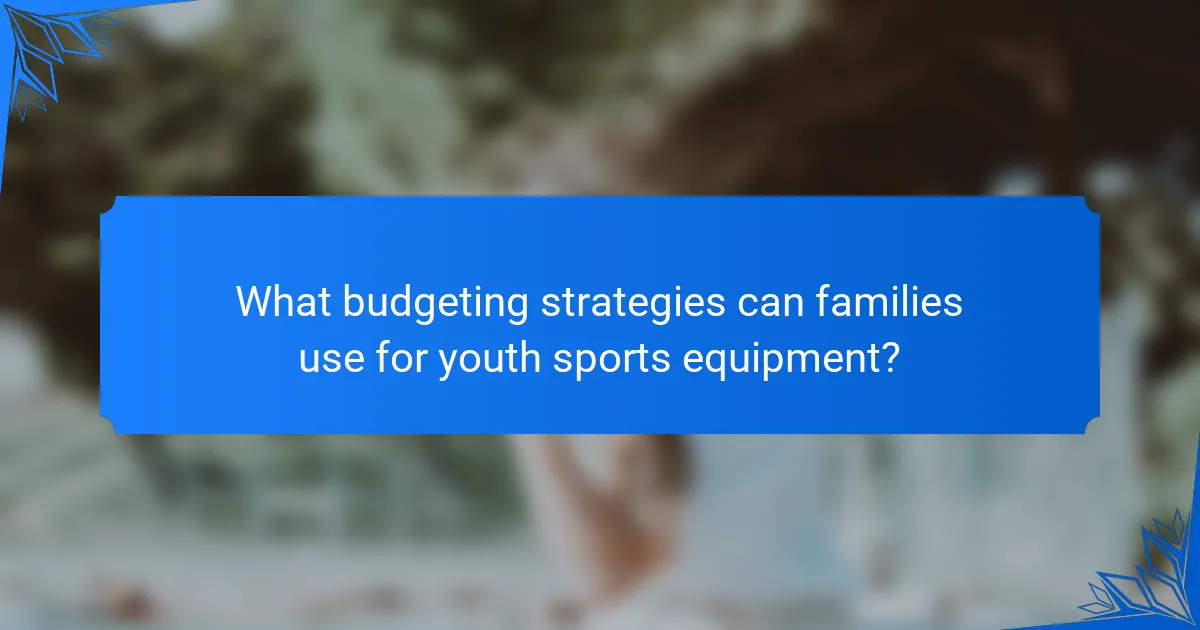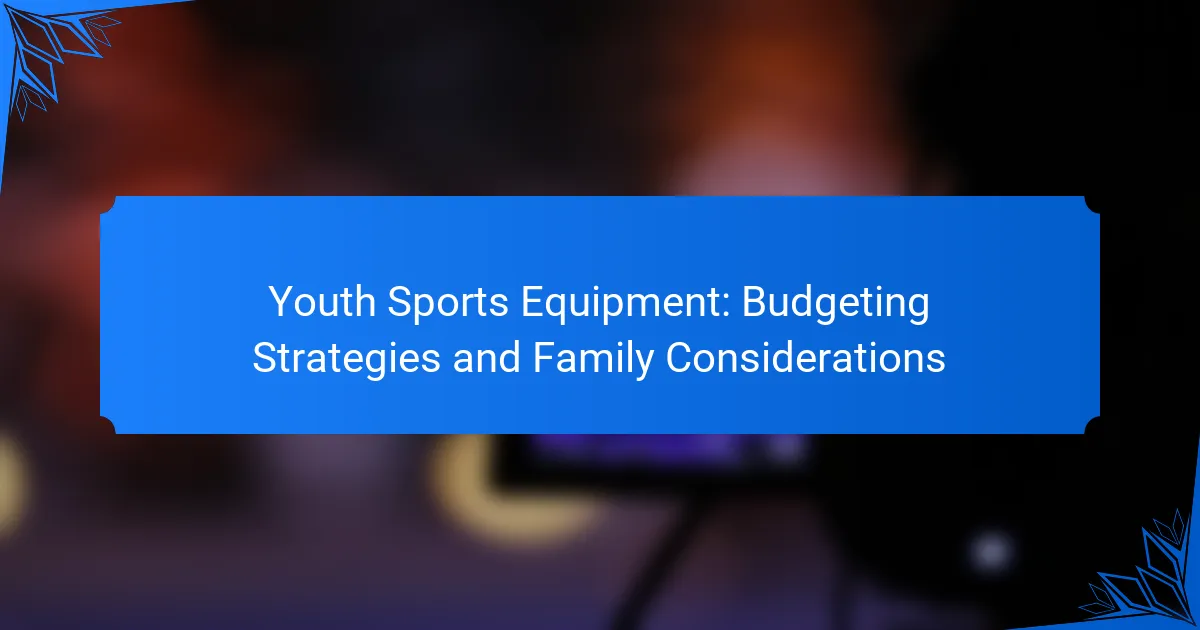Managing the costs of youth sports equipment can be challenging for families, but with effective budgeting strategies, it is possible to provide children with the necessary gear without breaking the bank. By prioritizing essential items, exploring second-hand options, and setting a clear monthly budget, families can navigate expenses while ensuring safety and quality in their purchases.

What budgeting strategies can families use for youth sports equipment?
Families can adopt several budgeting strategies to manage the costs of youth sports equipment effectively. By prioritizing essential items, exploring second-hand options, and setting a clear monthly budget, families can ensure their children have the necessary gear without overspending.
Prioritizing essential gear
Identifying and prioritizing essential gear is crucial for effective budgeting. Focus on the items that are necessary for participation, such as uniforms, safety equipment, and sport-specific gear. For example, a soccer player may need cleats, shin guards, and a ball, while a basketball player requires shoes and a jersey.
Consider the level of play and the specific requirements of the sport. Investing in high-quality essential items can often save money in the long run, as they tend to last longer and perform better.
Utilizing second-hand options
Second-hand options can significantly reduce costs while still providing quality equipment. Check local thrift stores, online marketplaces, and community groups for gently used gear. Many families sell equipment that is still in great condition as their children outgrow it.
When purchasing second-hand, inspect items carefully for wear and tear, and ensure they meet safety standards. This approach can help families save money while still equipping their young athletes properly.
Setting a monthly budget
Establishing a monthly budget specifically for youth sports equipment can help families manage expenses effectively. Determine a reasonable amount based on overall family finances and the sports involved. For instance, setting aside $50 to $100 per month can cover periodic purchases throughout the season.
Track spending closely to avoid overspending and adjust the budget as needed. This proactive approach ensures that families can meet their children’s needs without financial strain.
Exploring community programs
Many communities offer sports programs that include equipment rental or provide gear at reduced costs. Research local sports leagues, schools, and community centers for opportunities. Some programs even have partnerships with local businesses that offer discounts on equipment.
Participating in these programs can alleviate the financial burden of purchasing new gear while still allowing children to engage in sports activities.
Leveraging discounts and sales
Taking advantage of discounts and sales can lead to significant savings on youth sports equipment. Keep an eye out for seasonal sales, clearance events, and special promotions from sporting goods stores. Signing up for newsletters or loyalty programs can also provide access to exclusive discounts.
Additionally, consider shopping during off-peak seasons when prices may be lower. Planning purchases around these sales can help families stay within their budget while ensuring their young athletes have the necessary gear.

How can families find affordable youth sports equipment in the US?
Families can find affordable youth sports equipment in the US by exploring various options that offer significant savings. Utilizing online marketplaces, local consignment shops, and retailers with price matching can help families stay within budget while ensuring their children have the necessary gear.
Online marketplaces like eBay
Online marketplaces such as eBay provide a vast selection of new and used youth sports equipment at competitive prices. Families can often find items listed at a fraction of their retail value, especially if they are willing to buy second-hand gear. It’s advisable to check seller ratings and return policies to ensure a positive purchasing experience.
When using eBay, set alerts for specific items to get notifications when they become available. This strategy can help families snag great deals before they sell out. Additionally, consider bidding on auctions, which can sometimes lead to even lower prices.
Local sports consignment shops
Local sports consignment shops are excellent resources for affordable youth sports equipment. These shops typically sell gently used items at reduced prices, making them a budget-friendly option for families. Visiting these stores regularly can yield new inventory, especially during peak sports seasons.
Before purchasing, inspect the equipment for any signs of wear or damage. Many consignment shops also offer return policies, which can provide peace of mind. Engaging with shop owners can lead to insights on upcoming sales or special promotions.
Retailers with price matching
Many retailers offer price matching policies that can help families save money on youth sports equipment. If a family finds a lower price at a competitor, they can request the retailer to match it, ensuring they get the best deal available. This approach is particularly useful for new equipment that may not be available second-hand.
Before making a purchase, check the retailer’s price matching policy, as some may have specific requirements or exclusions. Keep a record of competitor prices and be prepared to show them at checkout. This strategy can lead to significant savings, especially on high-ticket items like bicycles or sports gear.

What are the key considerations for purchasing youth sports equipment?
When purchasing youth sports equipment, key considerations include safety, appropriate sizing, and material quality. These factors ensure that the equipment supports the child’s development while minimizing risks associated with sports activities.
Safety standards and certifications
Safety standards and certifications are crucial when selecting youth sports equipment. Look for products that meet recognized safety guidelines, such as those set by the American Society for Testing and Materials (ASTM) or the Consumer Product Safety Commission (CPSC). These certifications indicate that the equipment has undergone rigorous testing for safety.
Check for labels or documentation that confirm compliance with these standards. This can help prevent injuries and ensure that the equipment is suitable for young athletes.
Age-appropriate sizing
Choosing age-appropriate sizing is essential for comfort and performance. Equipment that is too large or too small can hinder a child’s ability to play effectively and safely. Always refer to the manufacturer’s sizing charts, which often categorize products by age, height, or weight.
For example, when buying a baseball glove, ensure it fits the child’s hand snugly but allows for movement. A good fit enhances confidence and encourages participation in sports.
Durability and material quality
Durability and material quality are important factors to consider, as youth sports equipment should withstand regular use. Look for items made from high-quality materials that can endure wear and tear, such as reinforced stitching and sturdy plastics or metals.
Investing in durable equipment may have a higher upfront cost but can save money in the long run by reducing the need for frequent replacements. For instance, a well-constructed soccer ball can last through multiple seasons, making it a worthwhile purchase.

What are the benefits of renting youth sports equipment?
Renting youth sports equipment offers families a cost-effective and flexible solution for their children’s athletic needs. This approach allows parents to provide quality gear without the financial burden of purchasing new items that may only be used for a short time.
Cost-effectiveness for growing children
As children grow quickly, their sizes and needs for sports equipment change frequently. Renting allows families to avoid the high costs associated with buying new gear every season, which can easily reach hundreds of dollars. Instead, they can pay a fraction of that amount for rentals, making it a budget-friendly option.
For example, renting a soccer kit might cost around $30 for the season, compared to purchasing a new kit that could cost upwards of $100. This significant savings can be redirected to other family expenses or activities.
Flexibility for seasonal sports
Renting youth sports equipment provides the flexibility to switch between different sports as seasons change. Families can easily rent equipment for soccer in the fall, basketball in the winter, and baseball in the spring without the hassle of storing unused gear. This adaptability is particularly beneficial for families with children who participate in multiple sports.
Additionally, renting allows families to try new sports without a long-term commitment. If a child decides they no longer enjoy a sport, parents can simply return the equipment without worrying about a wasted investment.
Access to high-quality brands
When renting, families often have access to high-quality brands that may be too expensive to buy outright. Rental services typically carry reputable brands known for their durability and performance, ensuring that children have the best equipment available. This can enhance their experience and performance in sports.
For instance, renting a top-brand baseball glove or a premium pair of cleats can significantly improve a child’s comfort and performance on the field, all while staying within budget. Families can take advantage of these high-quality options without the financial strain of purchasing them outright.

How can families assess the long-term value of youth sports equipment?
Families can assess the long-term value of youth sports equipment by considering factors such as resale value, frequency of use, and the balance between quality and price. Evaluating these aspects helps ensure that investments in sports gear provide lasting benefits and minimize unnecessary expenses.
Resale value analysis
Resale value analysis involves determining how much money can be recouped from youth sports equipment when it is no longer needed. Popular brands and well-maintained items typically retain higher resale values, often ranging from 30% to 70% of the original price. Families should research local marketplaces or online platforms to gauge current resale prices for similar items.
When purchasing equipment, consider opting for items that have a strong resale market. This can mitigate long-term costs, especially for gear that children outgrow quickly, such as bicycles or skates.
Usage frequency evaluation
Usage frequency evaluation focuses on how often the equipment will be used over time. Families should assess whether their child will engage in the sport regularly, as equipment that is used frequently provides better value. For instance, if a child plays soccer multiple times a week, investing in quality cleats makes sense.
To determine usage frequency, consider the sport’s seasonality and the child’s commitment level. If a sport is seasonal, weigh the investment against how many months it will be actively used.
Quality vs. price comparison
Quality vs. price comparison is essential for making informed purchasing decisions. Higher-quality equipment often lasts longer and performs better, which can justify a higher initial cost. Families should look for gear that meets safety standards while balancing affordability; spending a bit more upfront can save money in the long run.
When comparing options, create a simple list of features that matter most, such as durability, brand reputation, and warranty. This can help prioritize which aspects are worth spending more on and which can be more budget-friendly.



